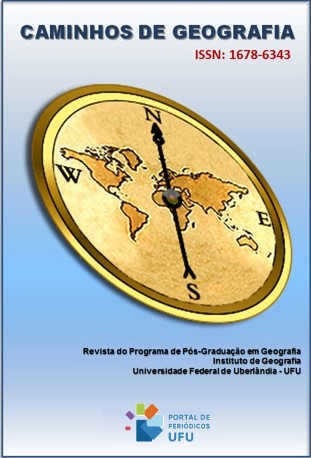LANDSCAPE ARCHEOLOGY AND GEOSYSTEMS: THEORETICAL-METHODOLOGICAL BASIS FOR INVESTIGATION OF THE TOCA DO ÍNDIO ARCHAEOLOGICAL SITE (CHIADOR, MG)
DOI:
https://doi.org/10.14393/RCG259970394Keywords:
Spatial continuity of the archaeological record, San Francisco Tradition, Landscape, Rock paintingsAbstract
Archaeological remains of the São Francisco Tradition have been recurrently found in the southern part of the state of Minas Gerais and in the Zona da Mata of Minas Gerais, such as the archaeological site Toca do Índio (Chiador, MG), the focal point of this article, whose objective is to interpret the alluded to archaeological site from a dialogical relationship between the geosystemic approach and landscape archeology. The results pointed to relationships with the regional landscapes given by the position of the cave in a strategic place, functioning as a lookout that reveals a wide regional view at a time when a thriving cover of semi-deciduous forests was an element of difficulty for displacements and observations. The site in question, in turn, boasts cave inscriptions that combine abstract figures and some zoomorphic elements recurrently found in paintings of the São Francisco Tradition, a cultural horizon whose affiliation of the traces found is more likely. It was also found that the site presents a considerable list of natural and anthropic threats, thus urging conservationist practices capable of protecting the site and its surroundings.
Downloads
Downloads
Published
How to Cite
Issue
Section
License
Copyright (c) 2024 Marcos Vinicius Dimas Lemos, Roberto Marques Neto, Luciane Monteiro Oliveira

This work is licensed under a Creative Commons Attribution-NonCommercial-NoDerivatives 4.0 International License.
Autores que publicam nesta revista concordam com os seguintes termos: a) Autores mantém os direitos autorais e concedem à revista o direito de primeira publicação, com o trabalho licenciado sob a Creative Commons Atribuição-NãoComercial-SemDerivações 4.0 Internacional. b) Autores têm permissão e são estimulados a publicar e distribuir seu trabalho online (ex.: em repositórios institucionais ou na sua página pessoal), já que isso pode gerar alterações produtivas, bem como aumentar o impacto e a citação do trabalho publicado. c) Em virtude de aparecerem nesta revista de acesso público, os artigos são de uso gratuito, com atribuições próprias, em aplicações educacionais e não-comerciais.











